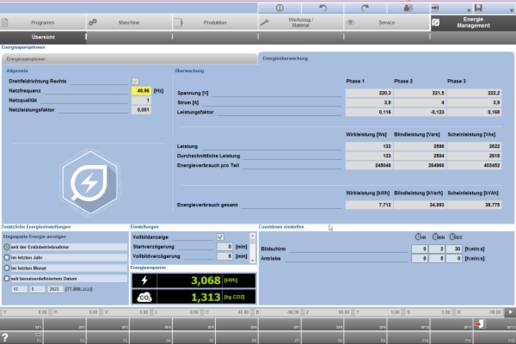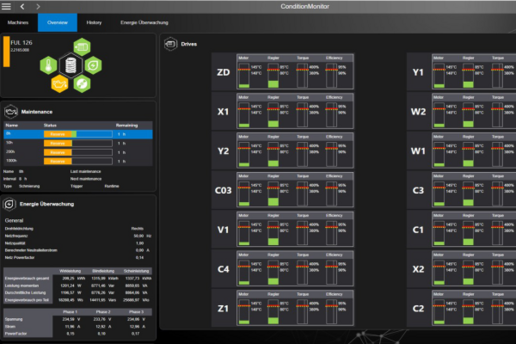How WAFIOS Is Giving the Topic of Sustainability a Boost
The EU is responding to climate change with a series of regulations and directives. Under these rules, all companies are required to run their business in a sustainable way and must be able to account for this. At its recent in-house trade fair “Innovation Days 2023”, WAFIOS AG in Reutlingen provided a report on what it has planned for this area in the future and what solutions it has developed for its customers. One solution showcased for the first time was a cloud energy management system, which provides full transparency for data such as consumption levels.
WAFIOS began introducing measures designed specifically to increase sustainability as many as 20 years ago. For instance, employee well-being and social commitment have long been a high priority, with projects on these issues being set up at a very early stage. The various aspects of sustainability are set out in the UN’s 17 Sustainable Development Goals. A key milestone for WAFIOS followed in 2013 with retrofit technology becoming available for WAFIOS machines to extend their service life. The “Paperless Factory” project was launched the same year. These measures were followed by the commissioning of an in-house co-generation unit in 2016 and the opening of an in-house childcare facility in 2017. Between 2018 and 2022, the company commissioned two photovoltaic systems. The second-hand machinery portal Second Life went online in 2021. Employees have been able to lease bicycles to use at work since 2022.
As a result of the energy crisis, the company introduced a range of savings measures, such as temperature control solutions, motion sensors, modern lighting, etc. in 2022, enabling it to cut energy consumption by 23% – the equivalent of 1,371 MWh.
The Basis: A Carbon Footprint Company
“Anyone keen to push the topic of sustainability within their company should start by drawing up their carbon footprint; this forms the basis,” explains Dr. Uwe-Peter Weigmann, CEO of WAFIOS. The Reutlingen-based company took this step itself when it started to become apparent which EU regulations the company would have to comply with in future. A carbon footprint is normally based on the emissions from three areas (scopes). Scope 1 is made up of your own company’s consumption figures, i.e., those for all machinery and the vehicle fleet. These are the emissions that you have control over and can have a direct impact on. A company has no or only indirect control over the emissions in scope 2. These are emissions generated by the procurement of energy for the company’s own use, i.e., by electricity, heat, steam, or cooling energy. Scope 3 is extremely complex and a company can only have an indirect effect on this scope. This scope covers all of the company’s upstream and downstream activities. Downstream activities include, for example, the transportation of sold products, their life cycles, leased property, plant and equipment, other branches, etc. Upstream activities include the transportation of purchased goods, the way in which employees travel to work, business trips, the temporary leasing of property, plant and equipment, etc. Scope 1 and 2 are relatively easy to calculate as the data can be recorded without any major difficulty,” says Dr. Uwe-Peter Weigmann, “which is why we started by calculating our consumption levels in these areas.”
This approach has proven successful: Between 2021 and 2022, WAFIOS managed to save 632 tonnes of CO², equivalent to around 15 percent. According to Dr. Uwe-Peter Weigmann, there are four areas of leverage that can help WAFIOS to reduce its emissions even further in future: ongoing improvements to energy efficiency, the expansion of clean energy under the company’s own direction – with photovoltaics being the key word here – the purchase of green energy, and the offsetting of CO2 emissions.
Machines with Energy Management Reduce Emissions
“At WAFIOS, energy saving does not stop at our own gates, but continues at our customers through their use of our machinery under scope 3,” says Dr. Uwe-Peter Weigmann. Any company producing or selling products today must know how much energy they consume at individual component level. After all, this question will come up later down the line at assembly level, at OEM level, and ultimately at end customer level. This development has also been underway for a long time in the production of bent wire components, tubes, or springs. “We have noticed changes to the reporting required for components. Our customers need their carbon footprints and energy consumption levels. In short, they need comprehensive energy management – and they now have access to this,” says Jörg Eisele, Head of the Tube and Wire Division and Sales Director at WAFIOS.
The Reutlingen-based machinery manufacturer divides energy management into three levels. At the lowest level – the standard scope – machines automatically switch to stand-by mode. And this not only applies to the control panel but also to the drives and control units, resulting in significant savings even at this level. The gains made using this approach are clearly displayed in the WPS 3.2 EasyWay control unit. This therefore helps the operator to actively save energy.
Cutting Energy Consumption with Intelligent Technology – iQbestspeed
TheiQbestspeed solution has long been available as part of the range of iQ functions for spring machines; the aim of this solution is to detect fluctuations in quality during spring production depending on the operating speed. The software locates the ideal operating point between the spread of quality attributes and speed.
An extra option has now been added: the measurement of energy consumption for each operating speed, forming the second level of energy management. The iQbestspeed feature now automatically selects the speed with the lowest energy consumption. Regarding this point, Jörg Eisele notes: “The customer can decide how they would like to optimize their process: whether they want the lowest possible spread – in other words, optimization based solely on quality – or whether they want maximum energy efficiency. In accordance with market demands, new parameters can now be read on the monitor with iQbestspeed: average energy and CO2 consumption per part.
Transparent Energy Management on the Cloud
But this is not all in terms of new software. On the Innovation Days, WAFIOS showcased a third level of management for the first time: the IoT suite, a Cloud-based energy management solution. Here, the data from all of the customer’s machines is collated on a central server, either on the customer’s premises or in the Cloud. Machine and order data is also pooled here. “Two more important aspects are worth mentioning here,” adds Jörg Eisele to conclude. “With our software, the user can adapt their reports to their individual needs. As such, they are able to meet all of their reporting obligations. Because one of the principles in our philosophy is to keep machines running for a long time, we offer the option of having older systems retrofitted with the latest energy management functions.”
Just as the topic of sustainability is becoming more important, so too the understanding of what makes the ideal production process is changing. Energy consumption and emissions are superceding previous economic factors or will gradually be regarded as such themselves sooner or later. Only transparent energy management and data processing in Cloud solutions will enable production processes to be optimized over the long term, particularly because this approach allows scope 3 emissions to be reduced. WAFIOS machines are now equipped to meet these criteria.

